MLS Power Rankings, Week 2: Bizarre results, late scores, golazos
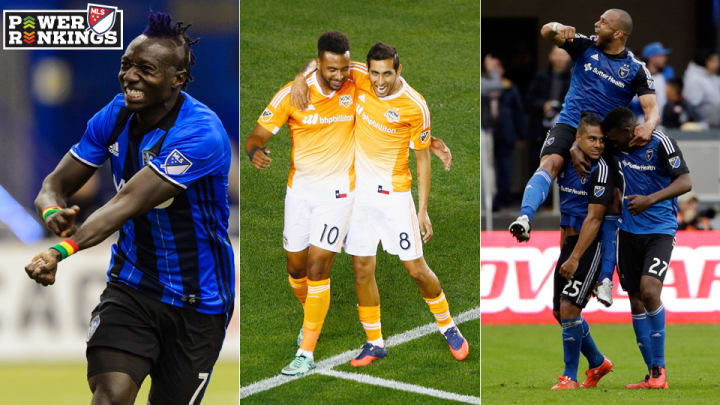
More late drama permeated Major League Soccer in the second week of the new season. Ten goals were scored in the 70th minute or later across the league’s 10 matches this weekend, including three game-winners.
After Orlando City SC’s two-goal stoppage-time comeback in Week 1, recent Colorado Rapids acquisition Marco Pappa stunned the LA Galaxy with a 95th-minute winner on Saturday. The Rapids’ 1-0 win over LA clearly delighted struggling coach Pablo Mastroeni, who ripped off his suit jacket and threw it to the ground in celebration on the bench.
The team on the other end of Orlando’s comeback, Real Salt Lake, put away a late result of its own against the Seattle Sounders. In his team’s home opener, Jámison Olave scored on an 86th-minute header to give RSL a 2-1 comeback win.
The Montreal Impact and Houston Dynamo had no such trouble in their matches, defeating the New York Red Bulls 3-0 and FC Dallas 5-0, respectively. The Red Bulls’ Supporters’ Shield defense is off to a shaky start following two losses to open the season, and reigning top Western Conference seed Dallas fell apart after a solid win of its own last week.
Jordan Smith of the Vancouver Whitecaps and the Chicago Fire’s Michael Harrington both earned the week’s only red cards for poor first-half tackles. Vancouver lost again, 2-1 to Sporting Kansas City, as Dom Dwyer got off the mark with a couple good finishes before Smith’s sending-off, while Chicago managed to hold Orlando to a 1-1 draw after neither team could score following the incident.
Meanwhile, the New England Revolution and D.C. United gave the league its first scoreless draw of the season, though the Revs heavily out-shot and out-possessed D.C. on Saturday. The next day, New York City FC took a 2-0 lead over Toronto FC in the first half but couldn’t hold it, as TFC came back for a 2-2 draw at Yankee Stadium.
Critiquing the 2016 MLS uniforms
Chicago Fire
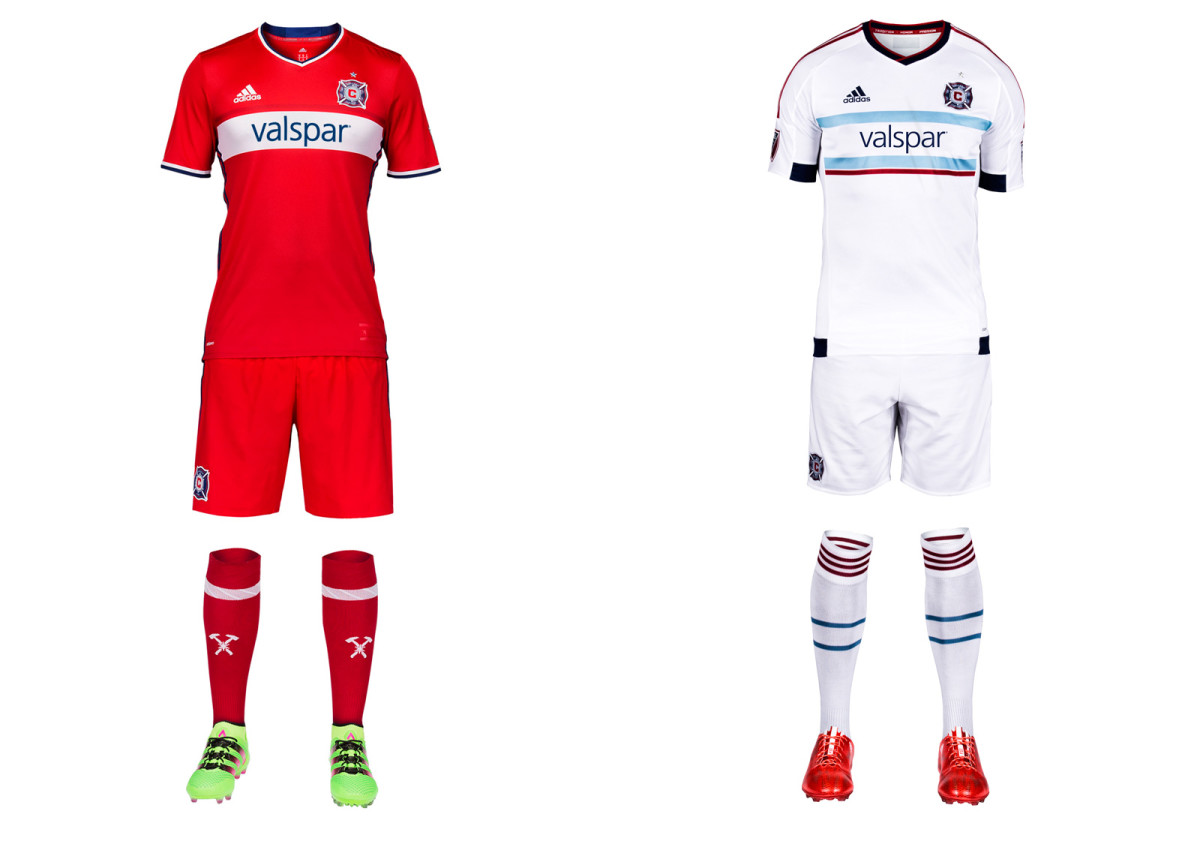
The optimism surrounding a new GM and head coach is accompanied by a welcome return to the red kit and single white hoop the Fire wore when winning trophies. Chicago was the first MLS team in mono-red and has dibs on a look that unfortunately became way too prevalent. The hoop on the new primary uniform is too thin, but otherwise it’s a crisp design that should be well received by fans, some of whom protested the red-and-blue offering worn in 2014-15. The all-white away kit featuring hints of the city flag carries over from last year.
Colorado Rapids
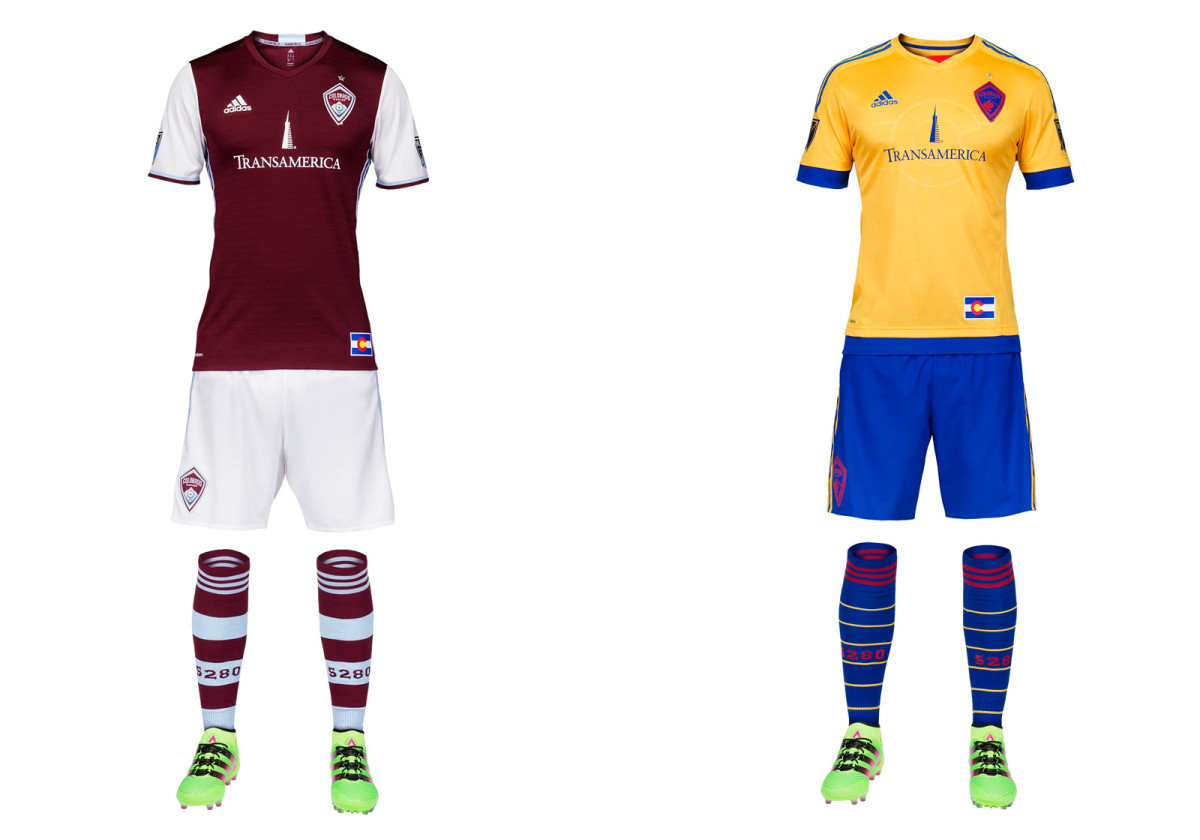
Colorado made just a few very subtle changes to its home uniform this year, and that’s fine. The three stripes moved from the shoulder to the side, there’s a bit of color on the cuffs and the hoops on the sock widened, which is awesome. The burgundy and white is elegant and immediately recognizable. The club's problem remains the logo, a skinny shield featuring a mountain (not rapids) similar to its NHL, NBA and MLB neighbors. It’s tough to suggest a fourth crest for a team that’s had trouble establishing an identity, but it might help. This one leaves no impact. Colorado’s sharp state flag-inspired away set carries over from 2015.
Columbus Crew SC
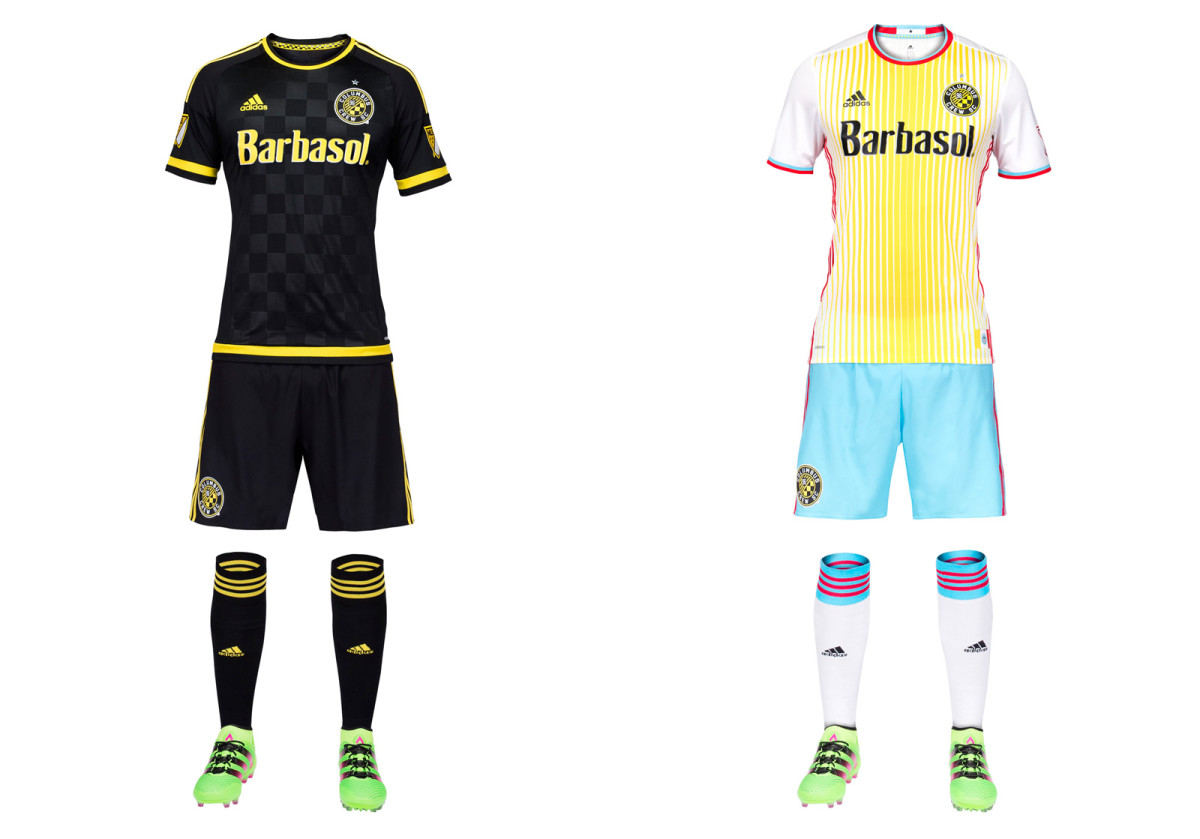
Once known as "America’s Hardest Working Team," Crew SC is trying too hard. For 17 years, Columbus was the only club in MLS, and one of the few in the world, to wear all-yellow. It was immediately recognizable, looked great on the field and was a genuine brand. Now it’s gone, replaced as the primary by last year’s away set. Mono-black is more closely associated with D.C. United. The new secondary is a shock to the system. Designed to reflect the yellow, white and red city flag, it’s certainly distinctive. Clubs are welcome to take chances with their away kits, but only if the overall brand holds steady.
D.C. United
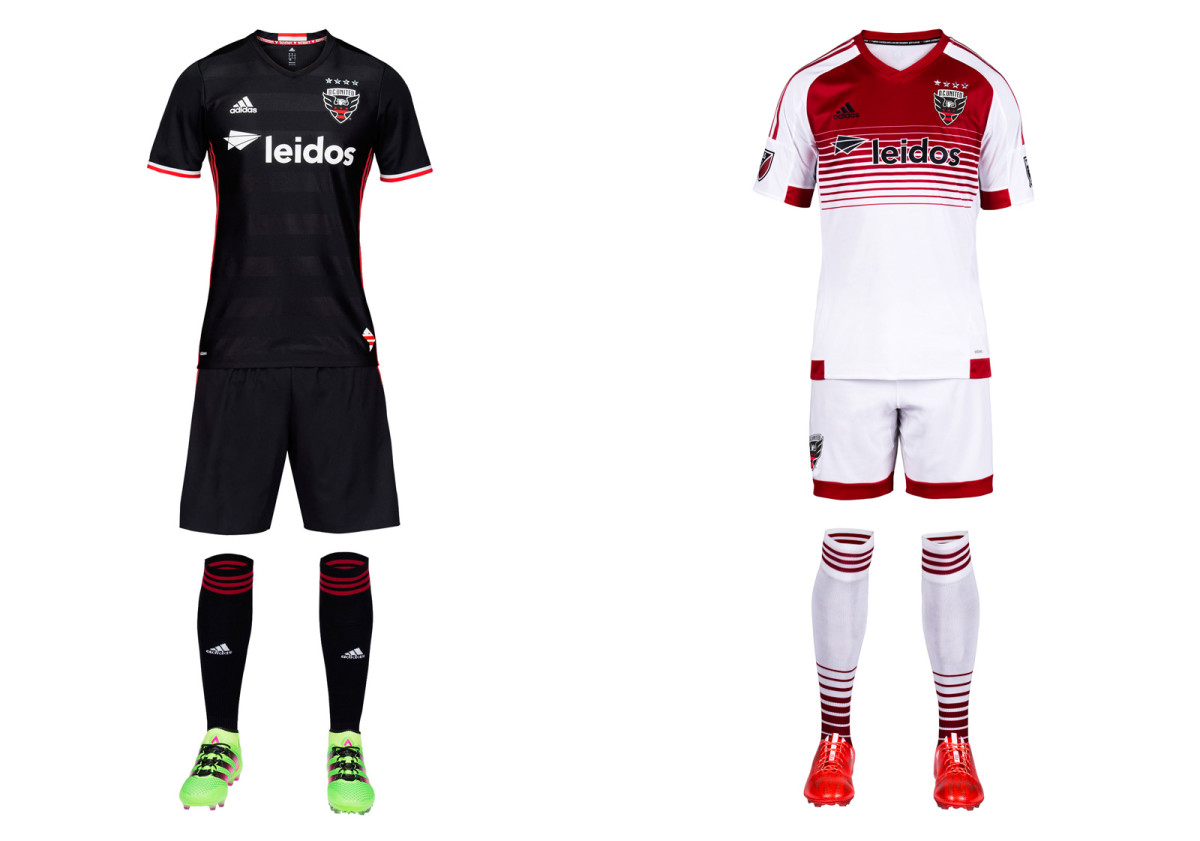
A new stadium in the nation’s capital (scheduled to open in 2018) is preceded by a new club logo, United’s first since 1998. We love the wings breaking through the shield and the redesigned font, but wish the stars on the city flag–which replaces the old ball and championship star–were a bit larger. They’re lost on the black background. The new home kit maintains the club’s classic, all-black brand and the sad absence of the white chest stripes that adorned the most iconic uniform in MLS history. There must be a way to bring those back.
FC Dallas
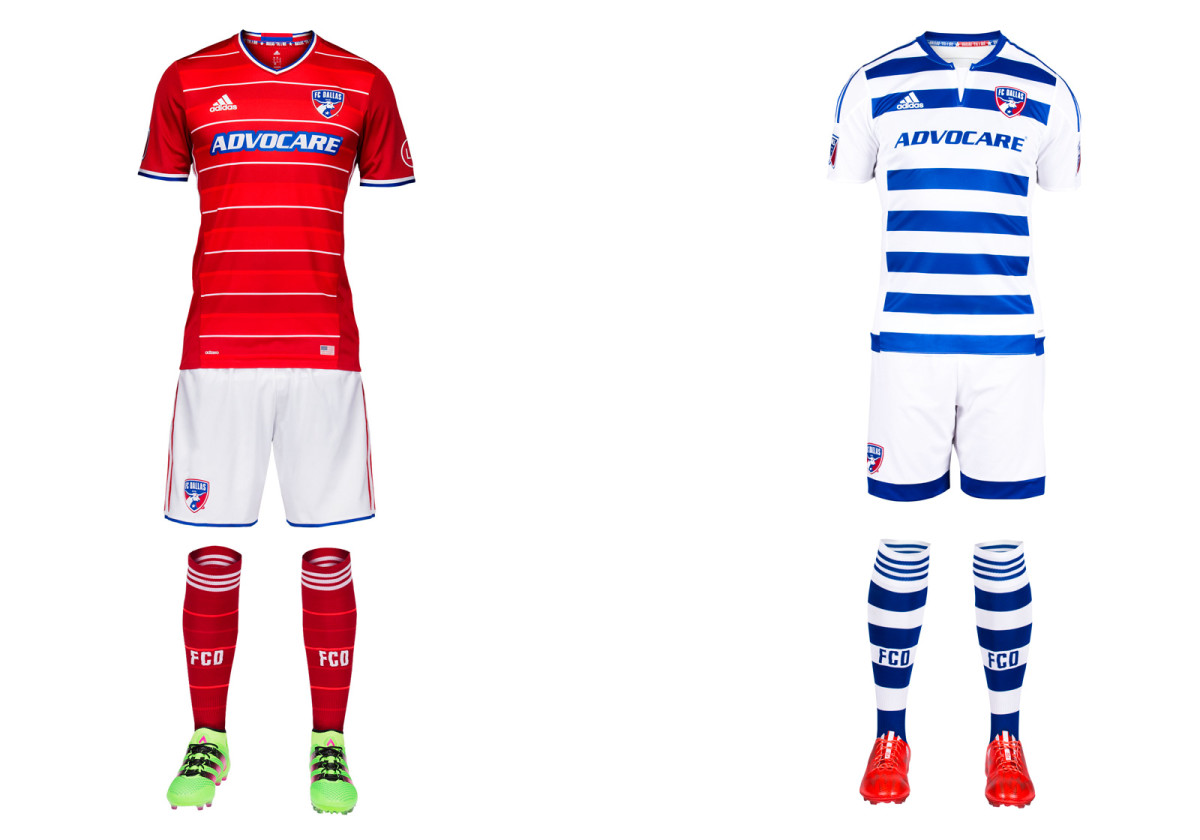
FCD’s new home kit is the nicest in club history. The hoops that accompanied the 2005 rebrand were a good idea but always poorly executed, and Dallas gave up on them two years ago. But the common mono-red look was a failure, leading to this year’s stylish primary. The pinstripe white hoops are sleek and distinctive and aren’t overwhelmed by Adidas’s panels and seams. The uniform pops with the addition of white shorts. Hopefully FCD takes the same approach with the blue-and-white secondary kit next year.
Houston Dynamo
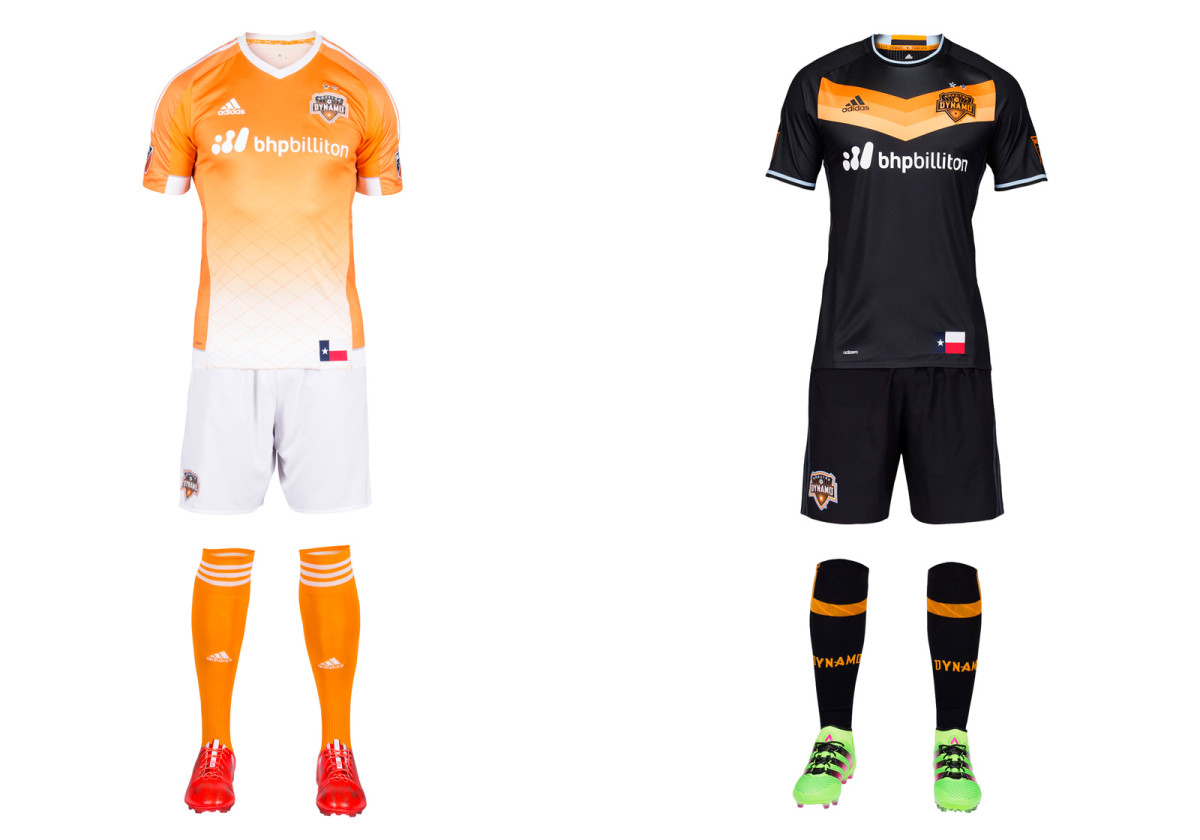
Houston’s new away uniform is a stunning departure from the traditional white. Black has been part of the club’s palette (check the logo). It now dominates the secondary kit save for a bright orange chevron on the chest reminiscent of the Astros’ famous “Tequila Sunrise” jerseys and the shirts Germany wore when winning the 2014 World Cup. We may not see the black too often at home (it’s hot and humid in Houston), but it should sell well. The orange fade on the primary set carries over from 2015. The Dynamo occasionally wear mono-orange, which is a mistake. The white shorts remain the way to go.
LA Galaxy
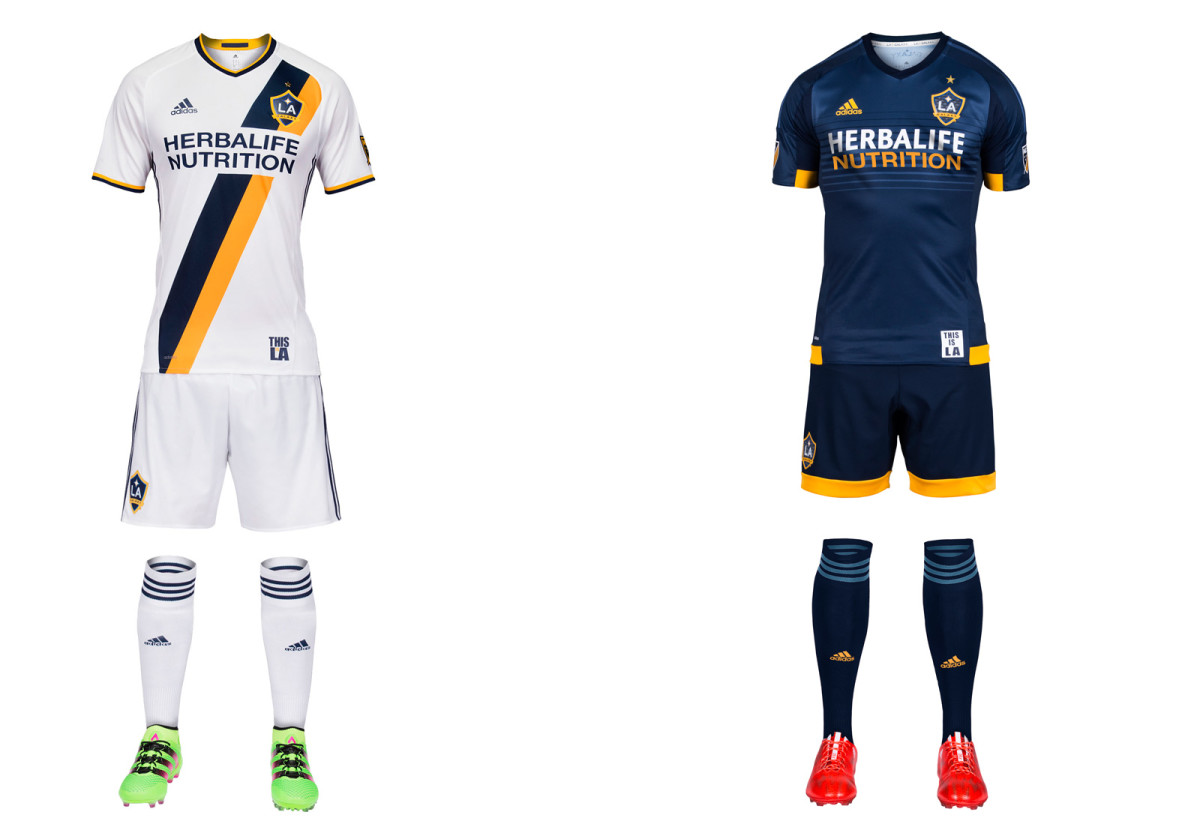
Credit to LA for sticking with the sash introduced in 2012. A club that started black-and-teal and progressed to yellow-and-green finally has an established look to call its own, and it’s a nice one. The new home uniform splits the sash into the modern team colors of blue and yellow, with corresponding flashes on the cuff and collar. It would be perfect save for the enlarged sponsor logo, which cuts too much from the middle of the shirt. The Galaxy carry over their classy blue away kit and thanks to the league's complex new championship star system they'll now wear one gold star above the crest, symbolizing five MLS titles.
Montreal Impact
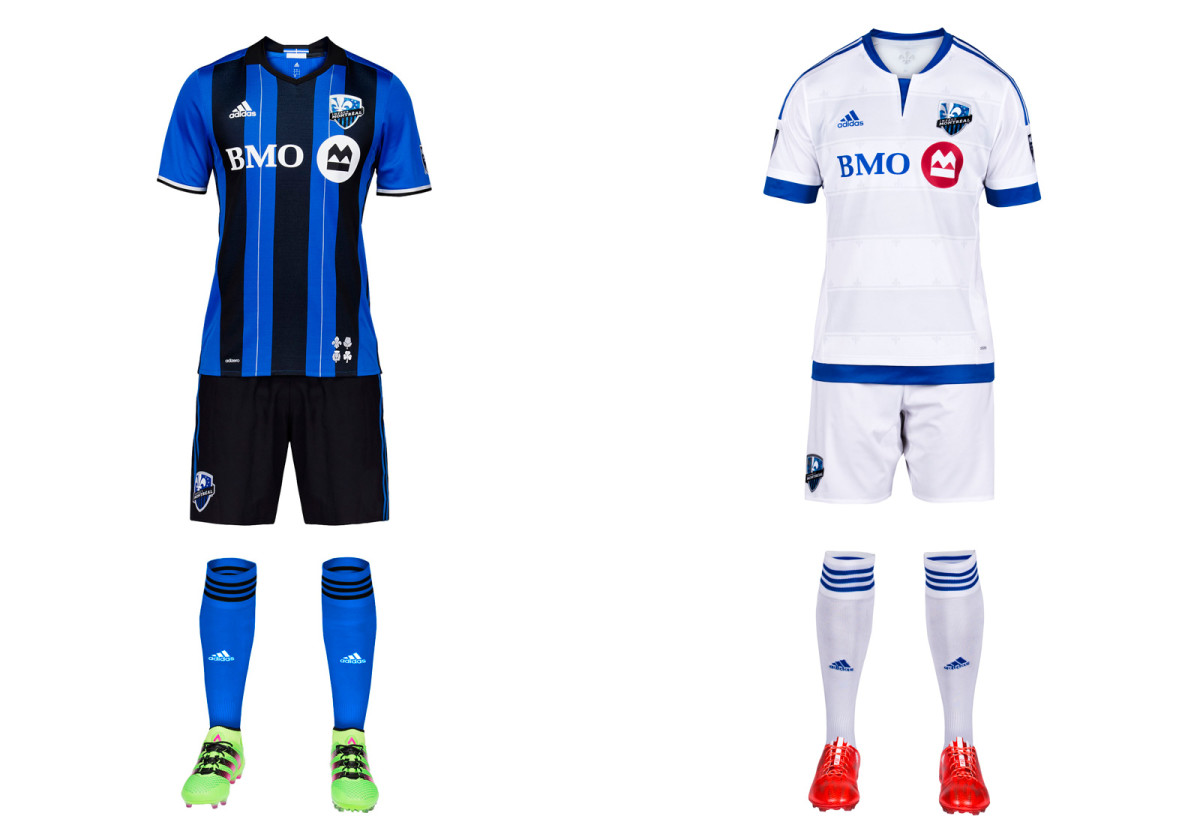
Finally! We never could understand why the Impact (launched in 1993) didn’t opt for their old school blue and black stripes when moving to MLS in 2012. There was history with the plain blue primary as well, but in the end it was just another anonymous monochromatic uniform in a league full of them. The stripes returned as a popular third option in 2013 and now have been elevated to their proper place as Montreal’s home kit. Black shorts, blue socks and silver highlights round out one of MLS’s most distinctive looks. Maybe the Impact can wear those shorts and socks on the road as well.
New England Revolution
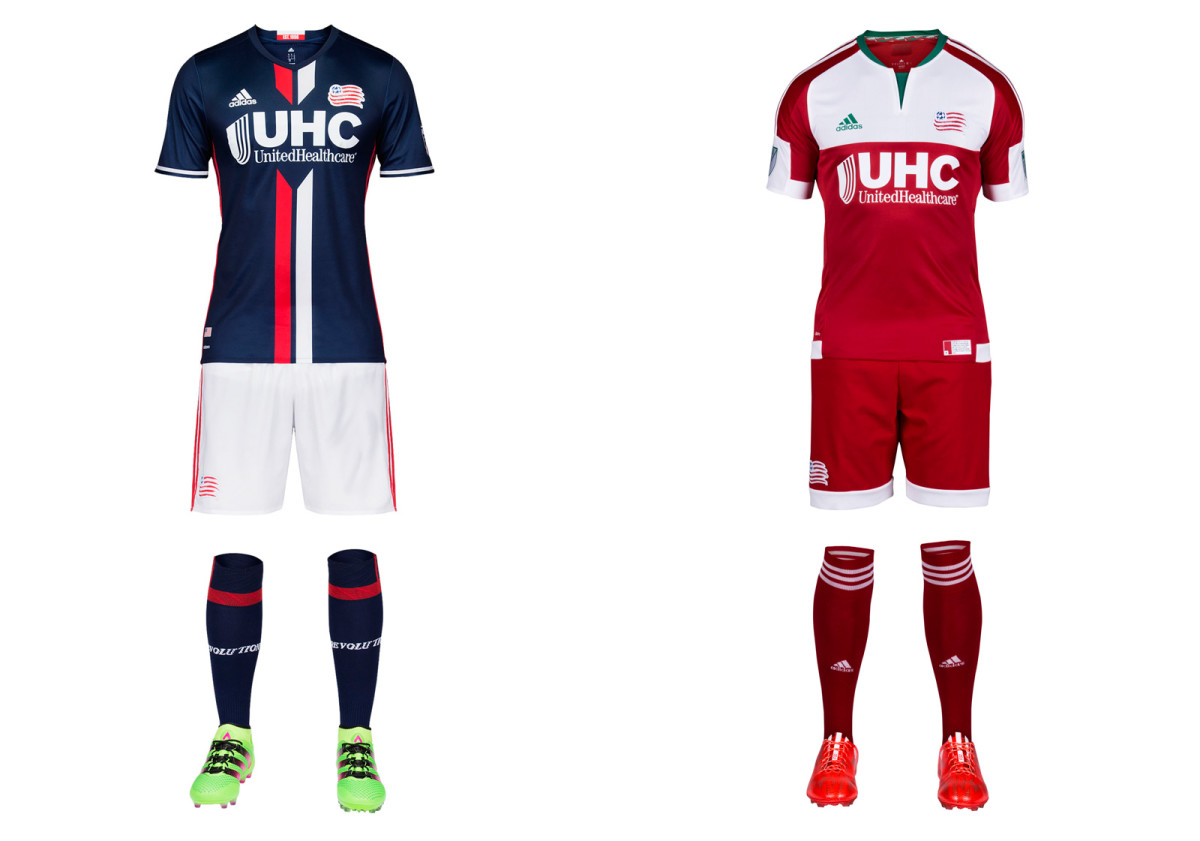
No team embraced the post-1996 regression to the bland like the Revs, who wore the most nondescript uniforms in MLS for years. That changed in 2014 with the addition of white shorts to the navy blue home kit. A total departure from the old all-white aways—a red homage to the old regional flag—followed last year. This season’s primary represents another step forward. The white shorts remain, thankfully, while a beautiful new jersey features red and white stripes down the center. The club said the look is inspired by American Revolution-era jackets. The secondary kit carries over. The inspiration there is commendable but the boxy execution is lacking.
New York City FC
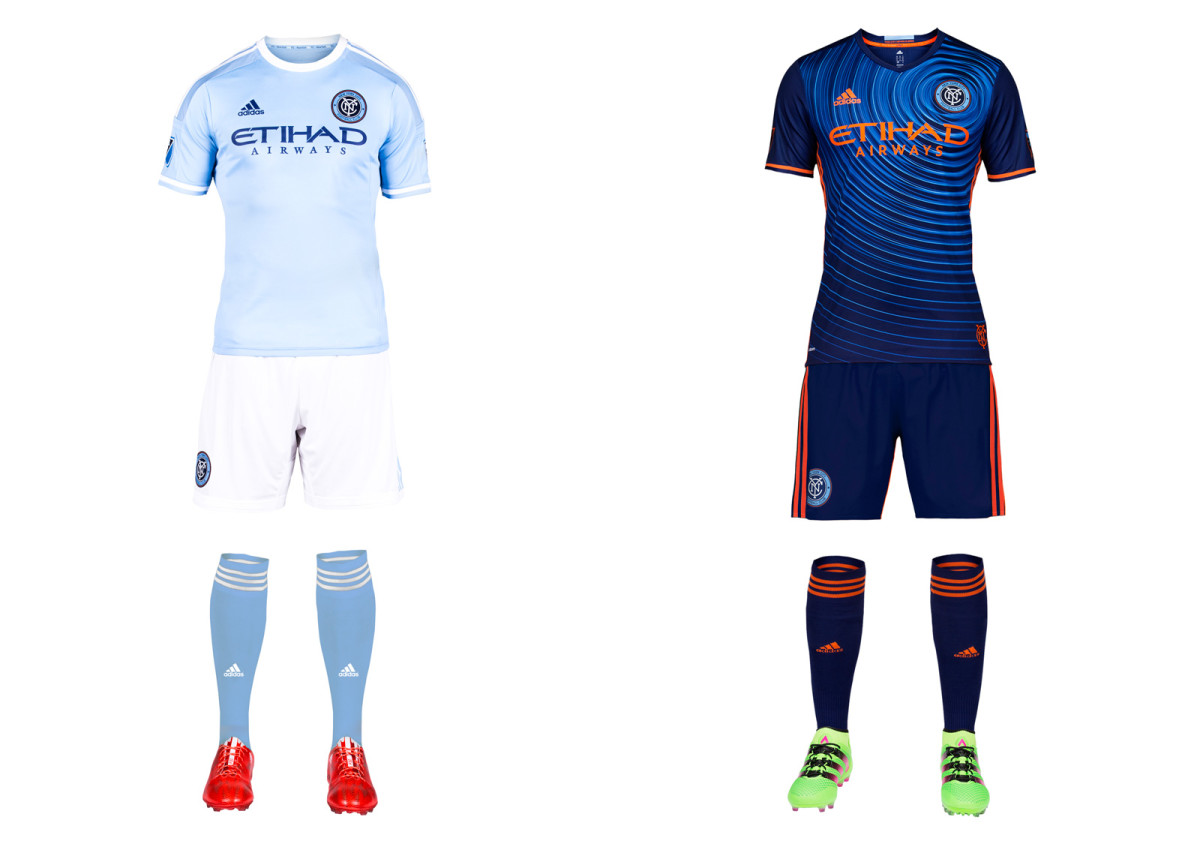
MLS didn’t need another all-black uniform, and NYCFC did the right thing by ditching last year’s away set in favor of something more aligned with the club’s colors and branding. What they came up with, however, will take some getting used to. The dizzying new secondary kit is anchored by a blue jersey with a “ripple pattern inspired by the energy of the five boroughs.” It’s unique, for sure, and while some won’t like it, secondaries don’t necessarily need to be timeless. Adidas also supplied orange shorts as an option, in case the mono-blue isn’t loud enough. NYCFC’s classy home uniform, which looks good even though Manchester City wore it first, carries over from its inaugural season.
New York Red Bulls
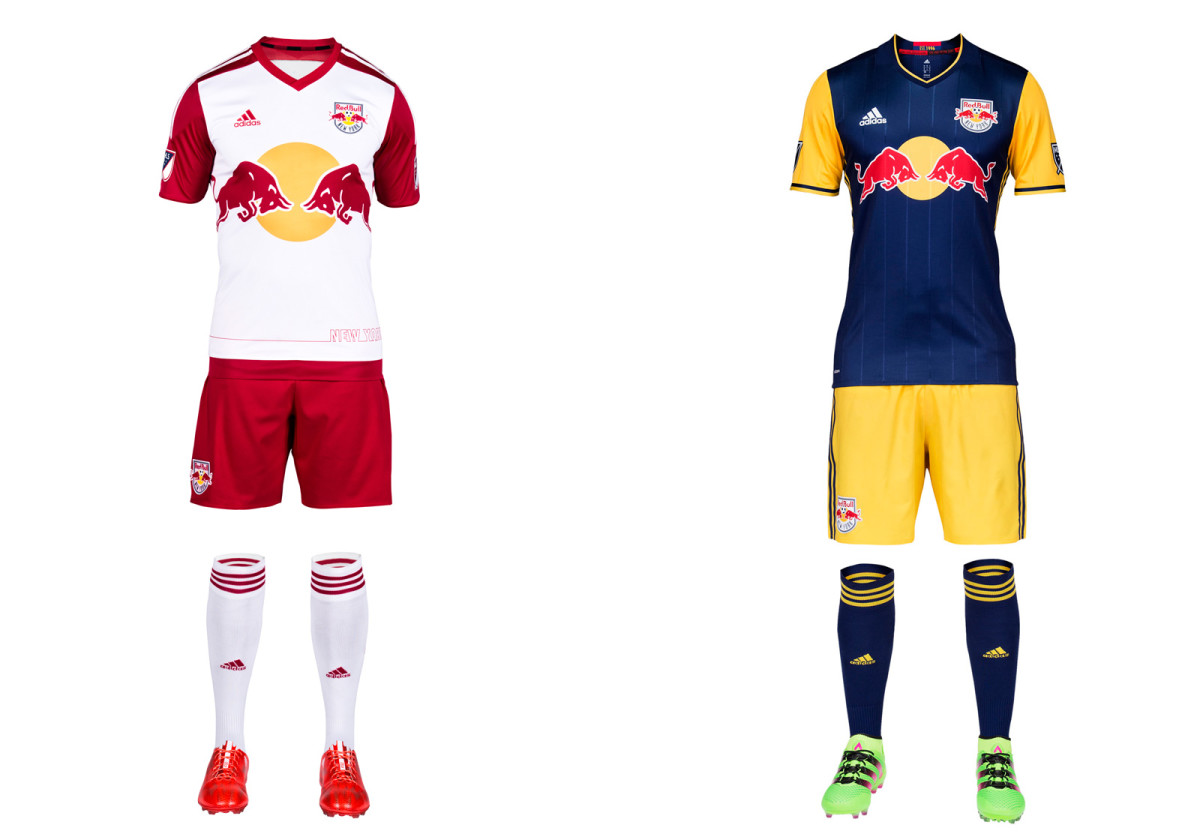
New York is red, except when it’s navy blue and yellow. Despite some supporters’ preference for a red away uniform, the Red Bulls are sticking with the colors they share with the parent company’s teams in Leipzig and Salzburg. The new secondary, which now features yellow sleeves, certainly is eye-catching even if it doesn’t stir fans’ souls. NYRB’s brand transcends the crest and kit, anyway. The stadium, history and the personalities who’ve donned MetroStar red-and-black and Red Bull red-and-white are what give this club its identity. NYRB sort of acknowledges that with the red-and-black necktape and MetroStars shield inside the new away jersey. The red-sleeved home kit is identical to last year’s.
Orlando City SC
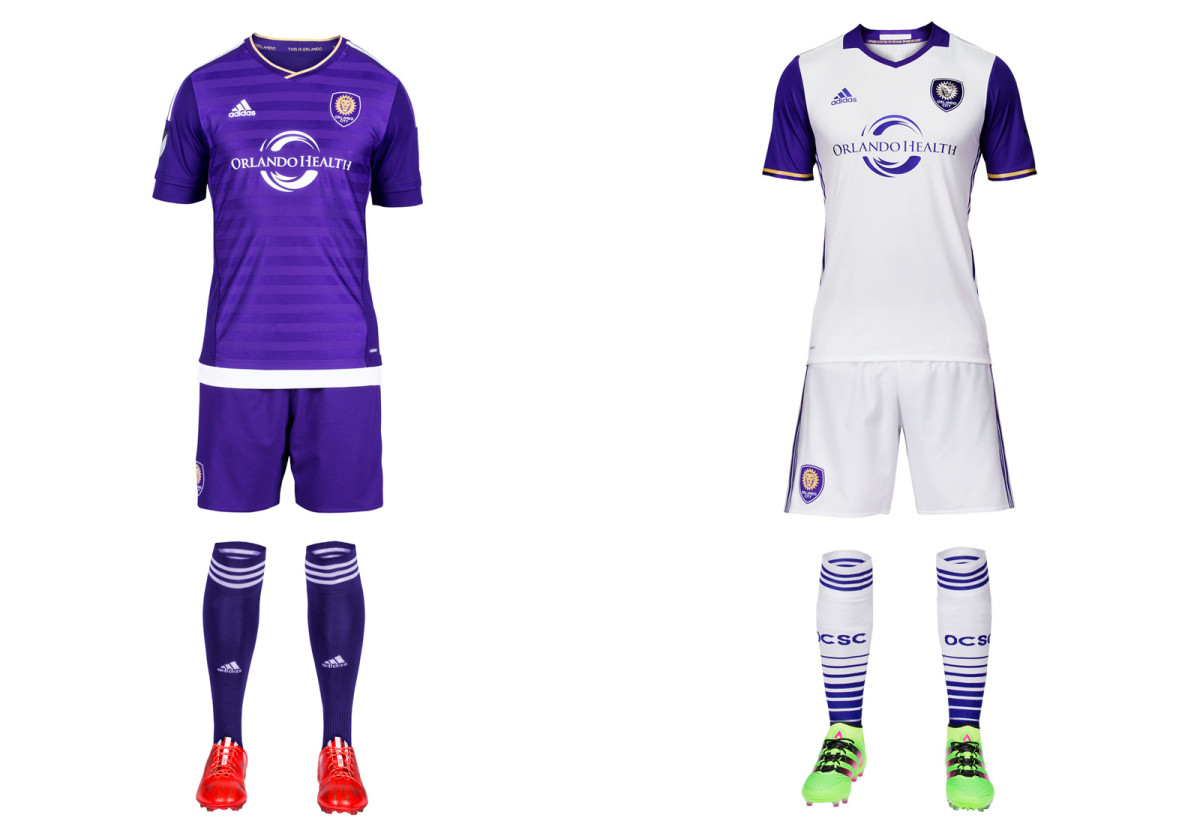
Purple is the defining feature of Orlando City’s brand, but the club blew it during its expansion season by rolling out a plain white away kit that looked too much like all the others. Now there’s progress in the form of purple sleeves, which add a welcome bit of color and make the new secondary uniform one that only Orlando could wear. The crest features a "3D" lion. The monochromatic home set stays the same. Swap the socks–white at home and purple on the road–and City would be close to perfect.
Philadelphia Union
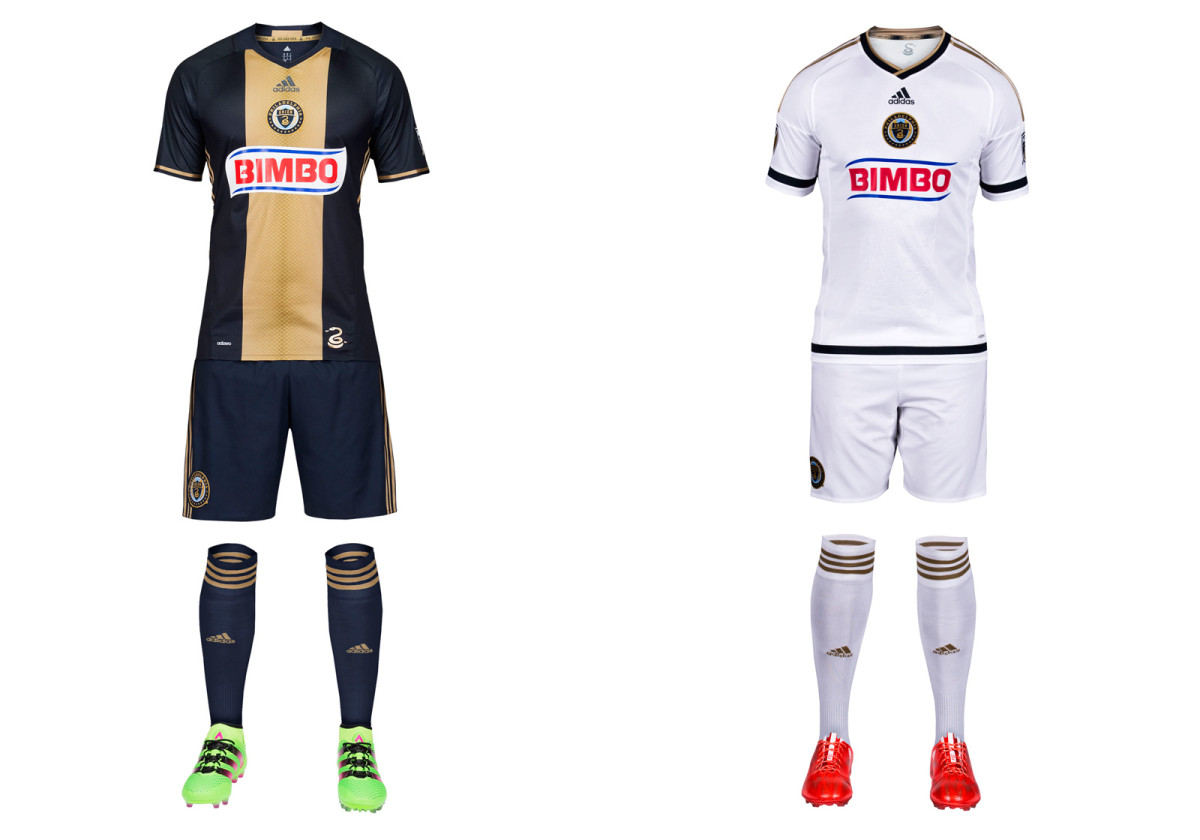
The Union’s home uniform is a modern classic, apart from a garish sponsor logo that looks pasted on instead of integrated with the rest of the jersey. This year’s new primary kit features a lighter gold down the middle, an understated snakeskin pattern (taken from the serpent in the club logo) and the departure of the pinstripes used in 2014-15. It’s as classy and distinctive a set as you’ll find. If only Bimbo could cooperate. Meanwhile, we’re stuck with the regrettable, lazy away kit for one more season.
Portland Timbers
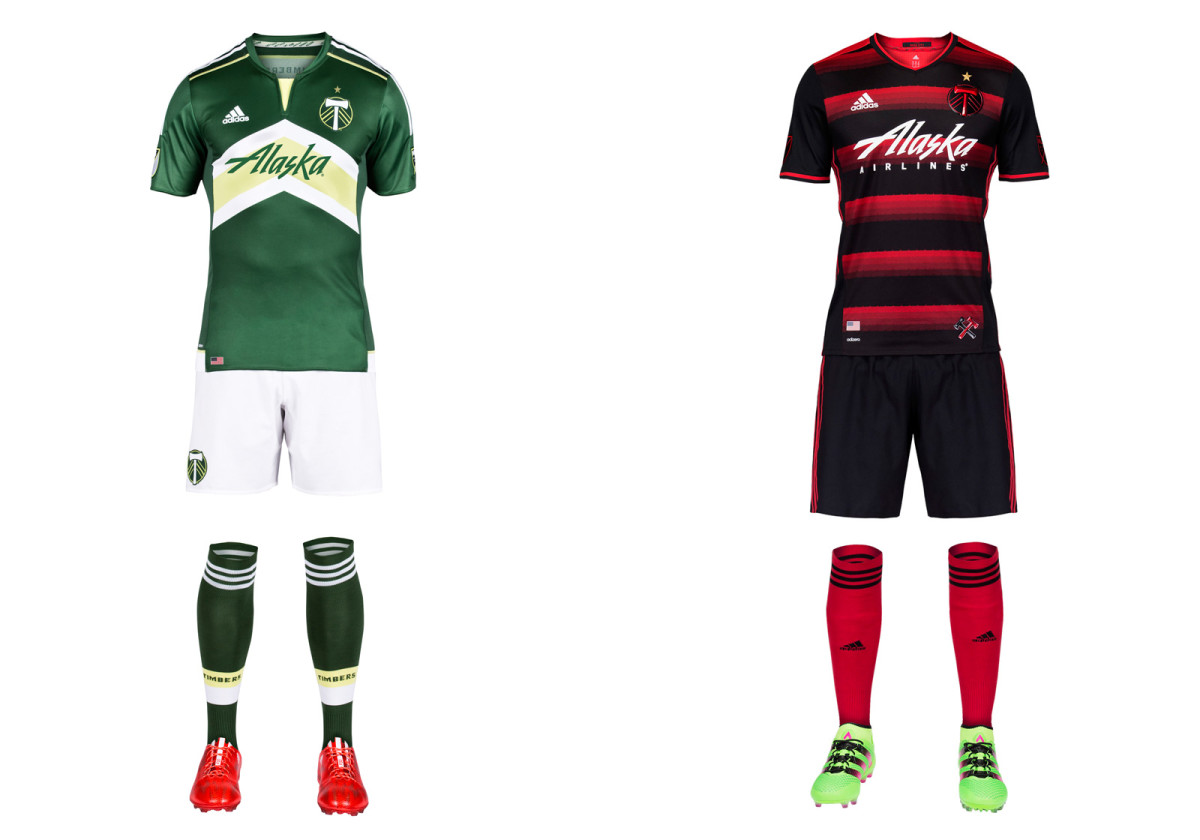
Portland’s "Rose City Red" away uniforms continue to darken, but the overall theme is maintained with the champions’ striking new secondary set. The mostly-black jersey (there's more red on the back) features hoops in shades of red complete with a subtle thorn motif. Red socks add a bit of contrast that would be lost if they were black. The green-and-white home kit is the same as last year’s except for a revised sponsor logo. For Timbers fans, of course, the best part is the new gold star above the crest.
Real Salt Lake
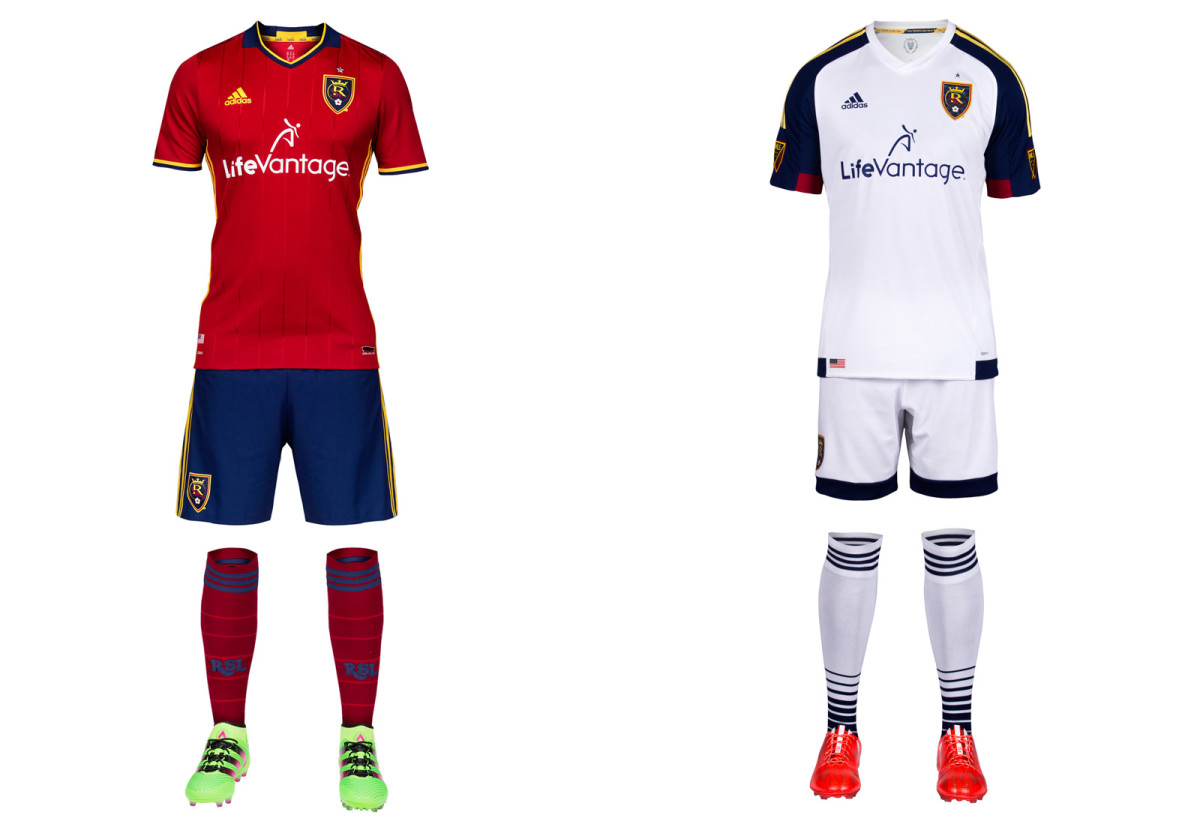
After six years in all-red, RSL at long last is returning to something resembling its unique, championship-winning look. After claiming the 2009 MLS title in red/claret jerseys (with blue/cobalt sleeves), blue shorts and blue socks, RSL inexplicably opted to become one of several mono-red teams. Bad uniforms and a trio of lost finals followed. If there was a kit curse, consider it reversed with the new home set, which features sublimated pinstripes on a sharp red jersey and a return to the cobalt shorts. RSL is RSL again. Let’s hope some variation of “victory gold” replaces the all-white secondary kit in 2017.
San Jose Earthquakes
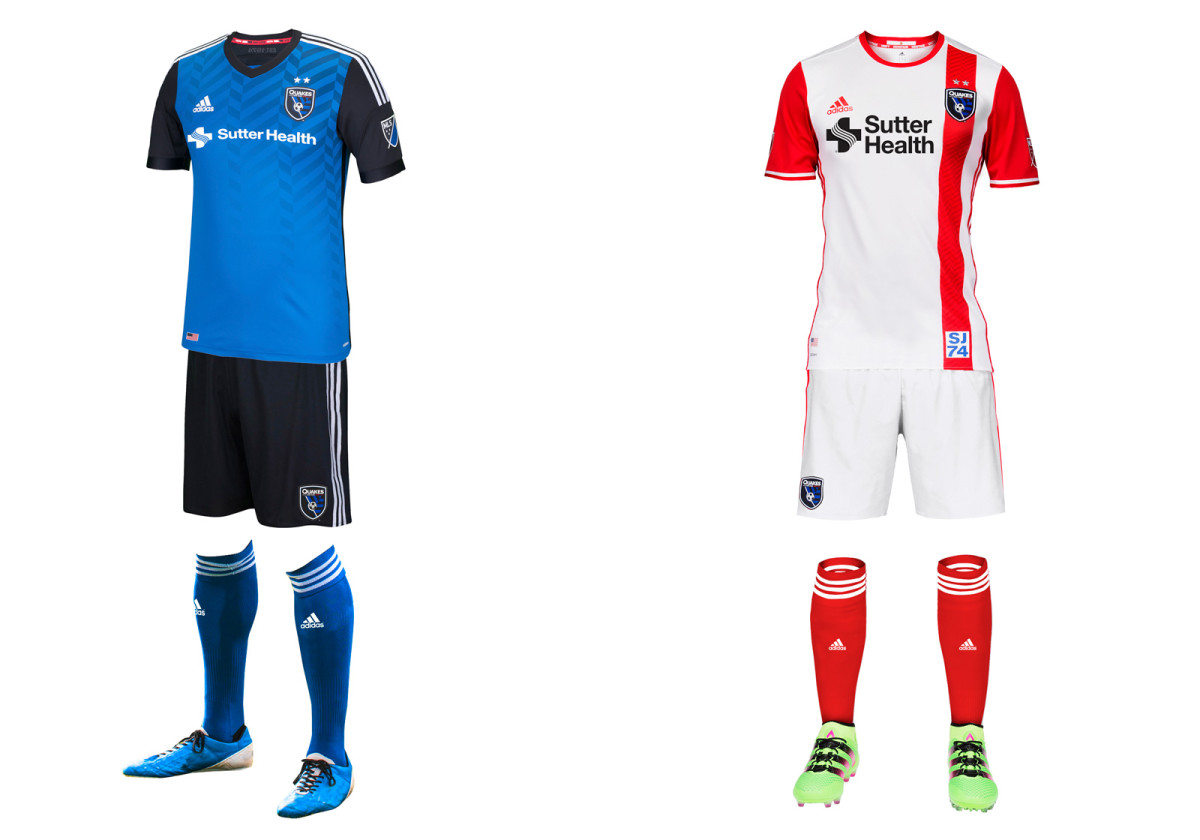
San Jose’s 2014 brand refresh now feels finished with the introduction of a much-improved away set that actually features some red, which connects the modern-day Quakes to their 1970s and ‘80s predecessors. The red stripe, sleeves and socks create a unique, balanced look that ties the club’s crest, primary and secondary kits together. There's also a tiny scorpion inside the neck paying tribute to the branding fiasco that was the San Jose Clash. The sharp blue-and-black home uniform carries over from last season with the addition of the Sutter Health logo. The Earthquakes were the last holdout—for the first time, every MLS team has a jersey sponsor.
Seattle Sounders FC
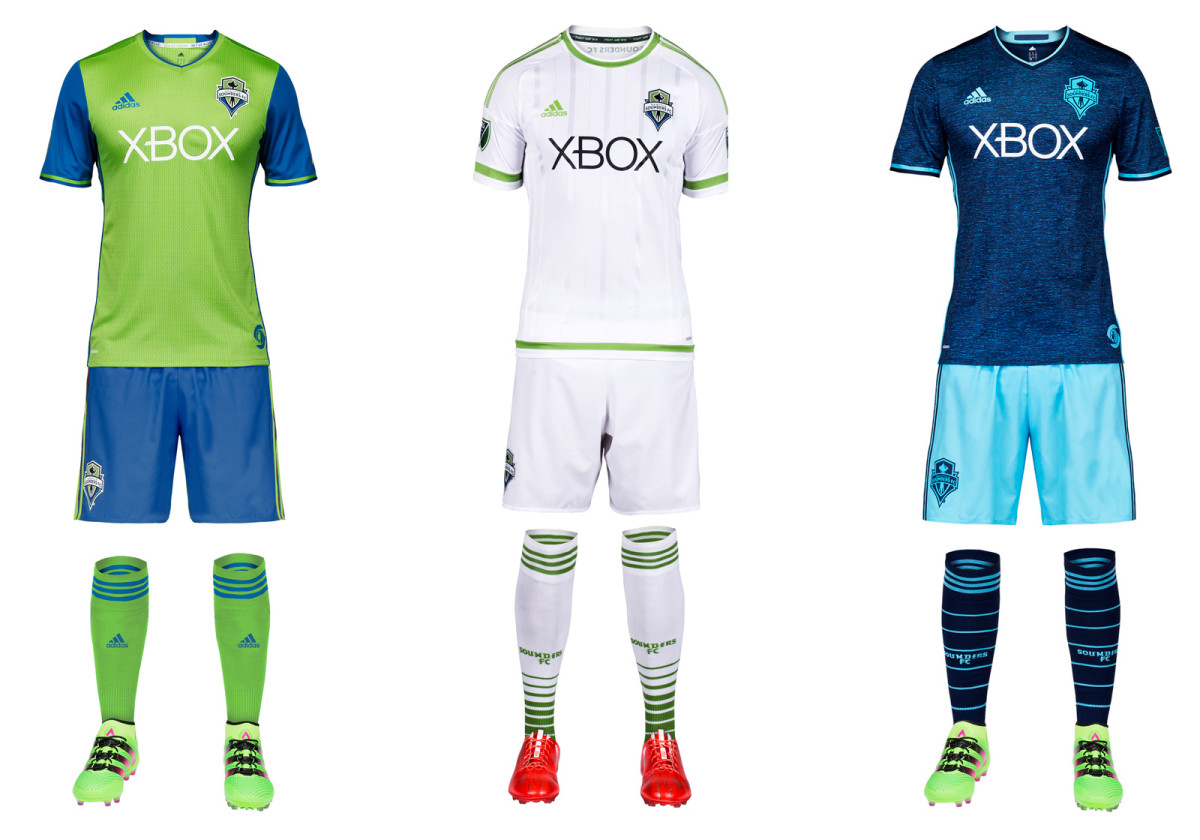
The only club to introduce two uniforms this year, the Sounders will sport a slightly adjusted version of their iconic rave green primary and a new third kit designed to reflect the colors of Puget Sound. The home set now features blue sleeves and an ’SS’ pattern on the body of the jersey. Seattle may continue the odd tradition of swapping the shorts and socks when wearing the primary on the road. It returns to cyan (and shades of darker blue) on the new third kit, which has a nice Cascadia feel. Hopefully, its arrival means the Sounders will wear the silly all-white secondary as infrequently as possible.
Sporting Kansas City
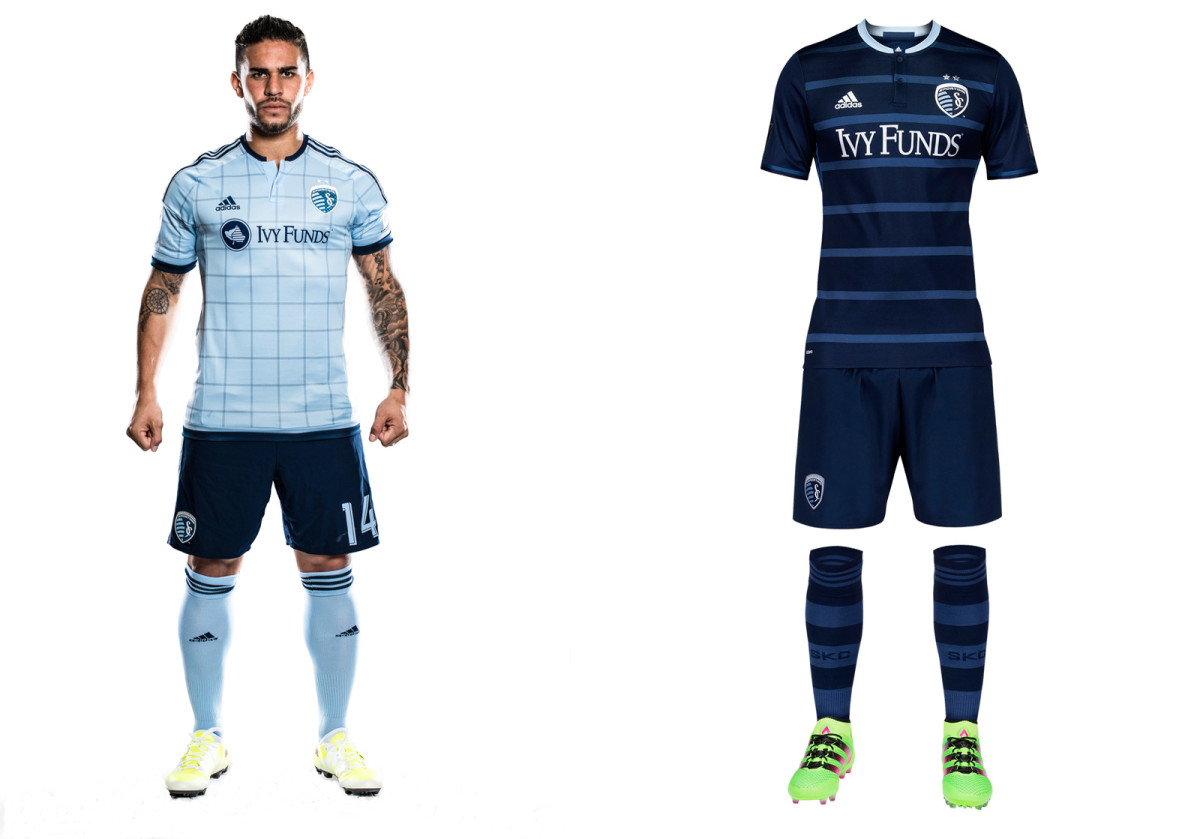
Uniforms typically run on two-year cycles, meaning Sporting had no choice but to move on from its spectacular hooped 2014-15 away set. The replacement is nice enough and the jersey looks good on its own, but the full kit is a bit bland in comparison. The thin hoops are "tonal" rather than "Sporting" blue. The metallic silver numbers and sponsor logo add a bit of glitz. The checkered home uniform debuted last year and still looks good with the dark blue shorts. SKC also will continue wearing its all-white third kit on occasion.
Toronto FC
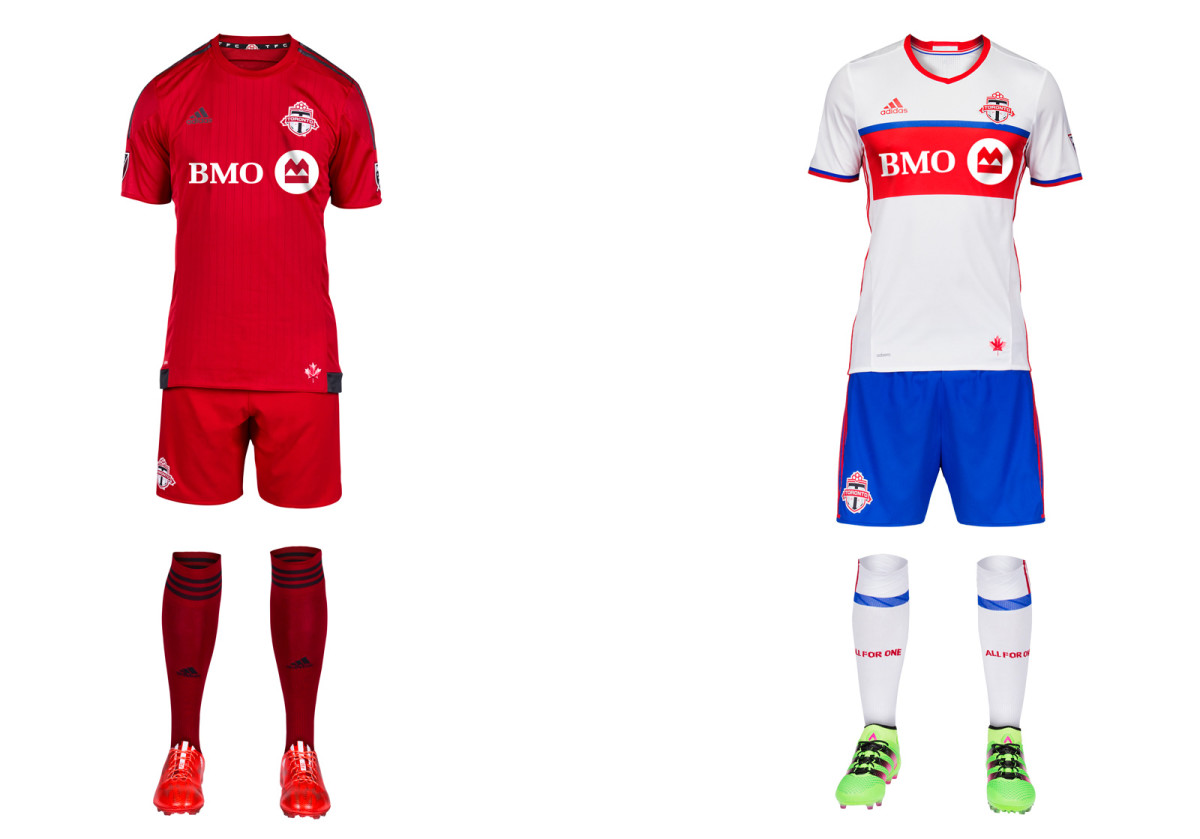
Entering its 10th season, TFC will include blue in its uniform for the first time. The club’s new away uniform is a colorful nod to the city and its soccer past. Toronto’s flag and its NHL, MLB and CFL teams are primarily blue, and the NASL’s Metros-Croatia and Blizzard wore red and blue in the 1970s and ‘80s. The kit stands out without being garish and means something to the club. Well done, TFC. It also can be worn with red shorts. Gone is the classy dark gray, which we wish was more prominent in the all-red primary.
Vancouver Whitecaps
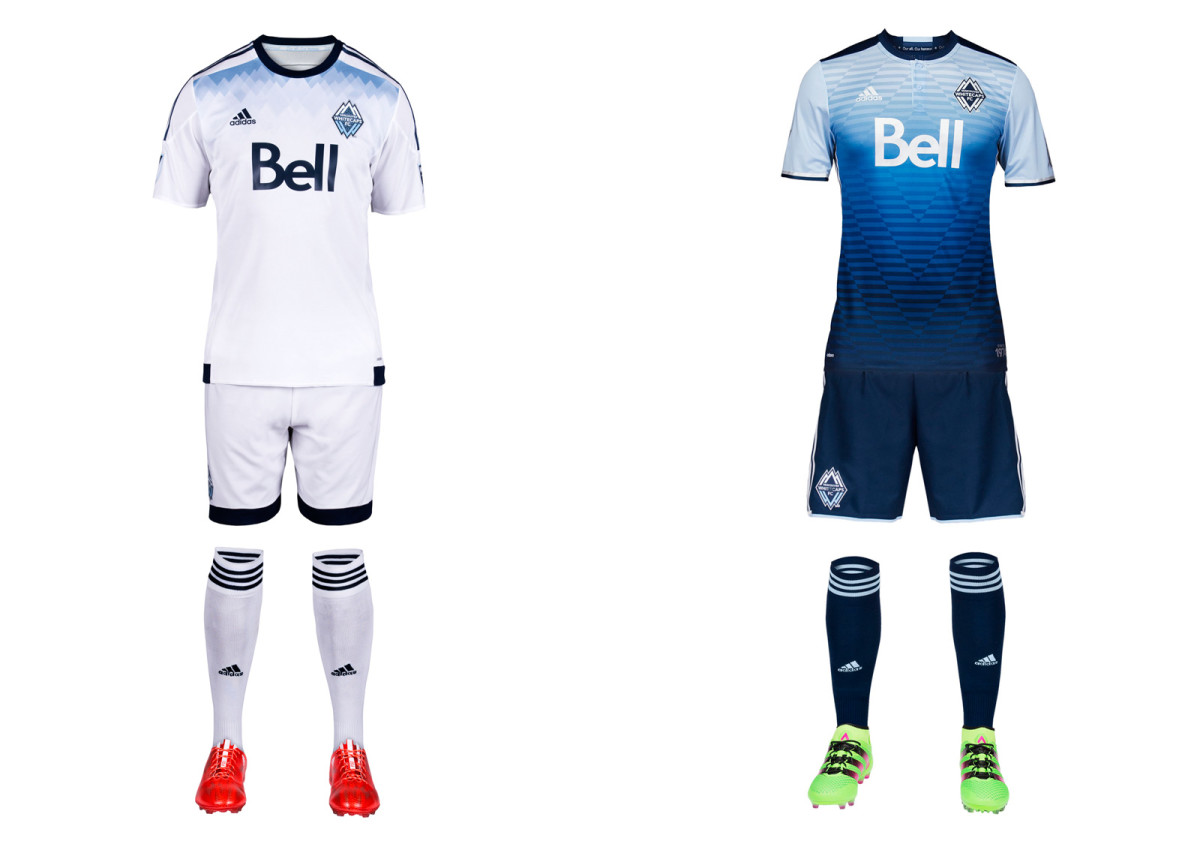
Vancouver’s new away uniform is its most daring design to date, barring the brown third kit introduced in 2012. But where that one was forgettable, the team’s “Sea to Sky” jersey leaves an impression. The blue gradient evokes the horizon, the North Shore Mountains reflecting on the surface of the water and the club’s initials. It’s gorgeous. The all-white primary carries over from 2015. It includes a bit of subtle blue shading at the shoulders but is otherwise pretty anonymous. The Whitecaps just proved they can do better.
Capping off a week that included some bizarre results, the San Jose Earthquakes were up 2-0 on the Portland Timbers until Jack McInerney’s consolation goal with one minute left.
It finished 2-1 in San Jose’s favor, even though the Earthquakes left two Designated Players, Innocent Emeghara and Matías Pérez García, on the bench the whole game.
Read on for some more highlights from Week 2 of the MLS season:
Coach’s Corner: Chicago tactical flexibility
In his short time as Chicago manager, Veljko Paunović has instilled a sense of belief and a new tactical understanding that led to an undefeated preseason. The Fire has just one point from two games so far in the regular season, but the flexibility it has shown in the past couple months could be important later in the season.
As teams shift players around to account for injuries, international duty and loss of form, being able to play more than one system becomes more important. Chicago has moved between a 4-2-3-1 and 5-3-2 already so far, depending on the opponent, location and game situation.
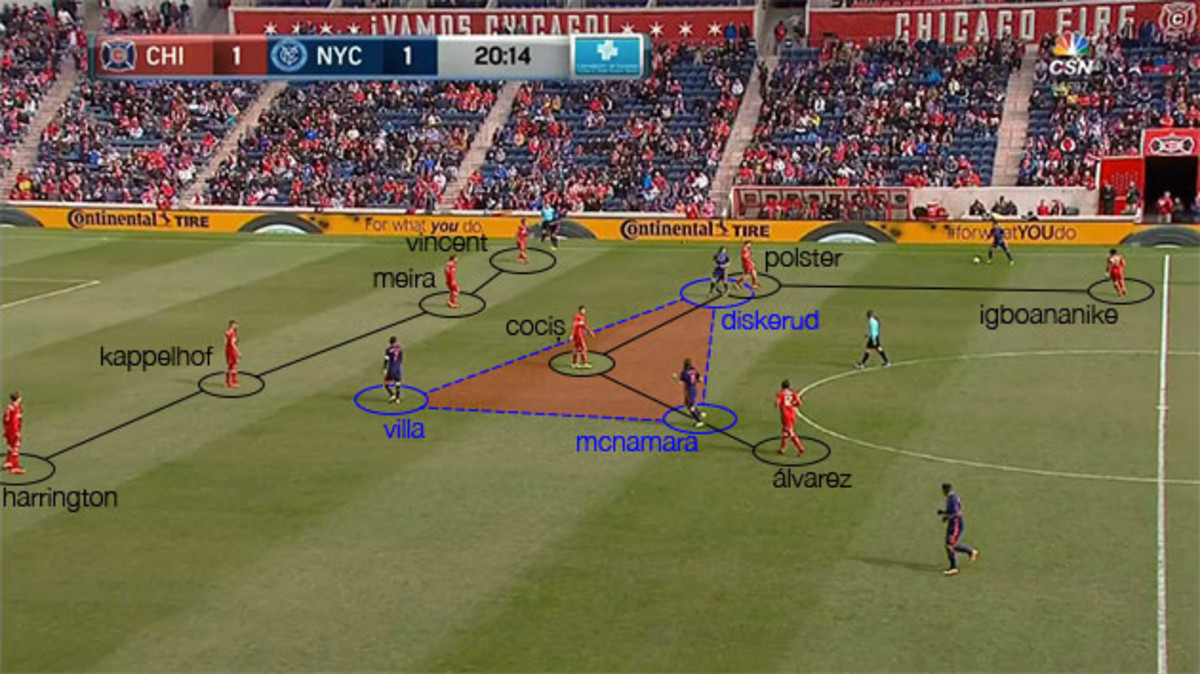
Paunovic brings unique experience, style to Chicago Fire's reboot
The Fire started Week 1 against NYCFC with a four-back arrangement. Chicago couldn’t take as many liberties moving forward, though, or risk getting too stretched in transition moments as NYCFC won the ball.
The central midfielders had to split farther apart to compensate and fill spaces defensively, leaving a gap ahead of the back line and central defenders with a dilemma about how to support if a runner checked off the front line.
NYCFC’s three central-most players, David Villa, Mix Diskerud and Thomas McNamara, overloaded the channel against fewer numbers due to the lack of compactness.
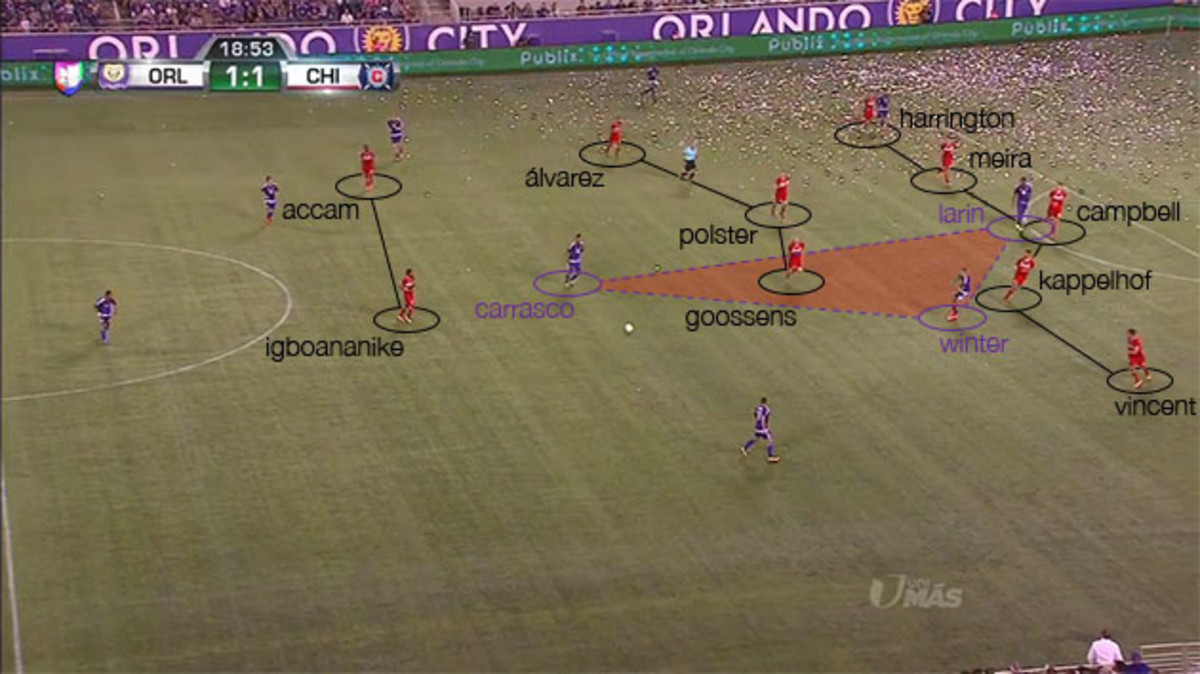
Chicago moved to five backs in the second half against NYCFC and started that way against Orlando on Saturday, until Harrington was sent off. With three central defenders, the Fire had easier cover built into the team’s starting shape.
If a forward checked back, a central defender could follow him without giving up as much in behind, as the other two could slide over to cover much easier, and the near-side wingback could tuck in. It allowed the central midfielders more freedom in attack, while also compensating for the lack of team compactness while they recovered toward their own goal.
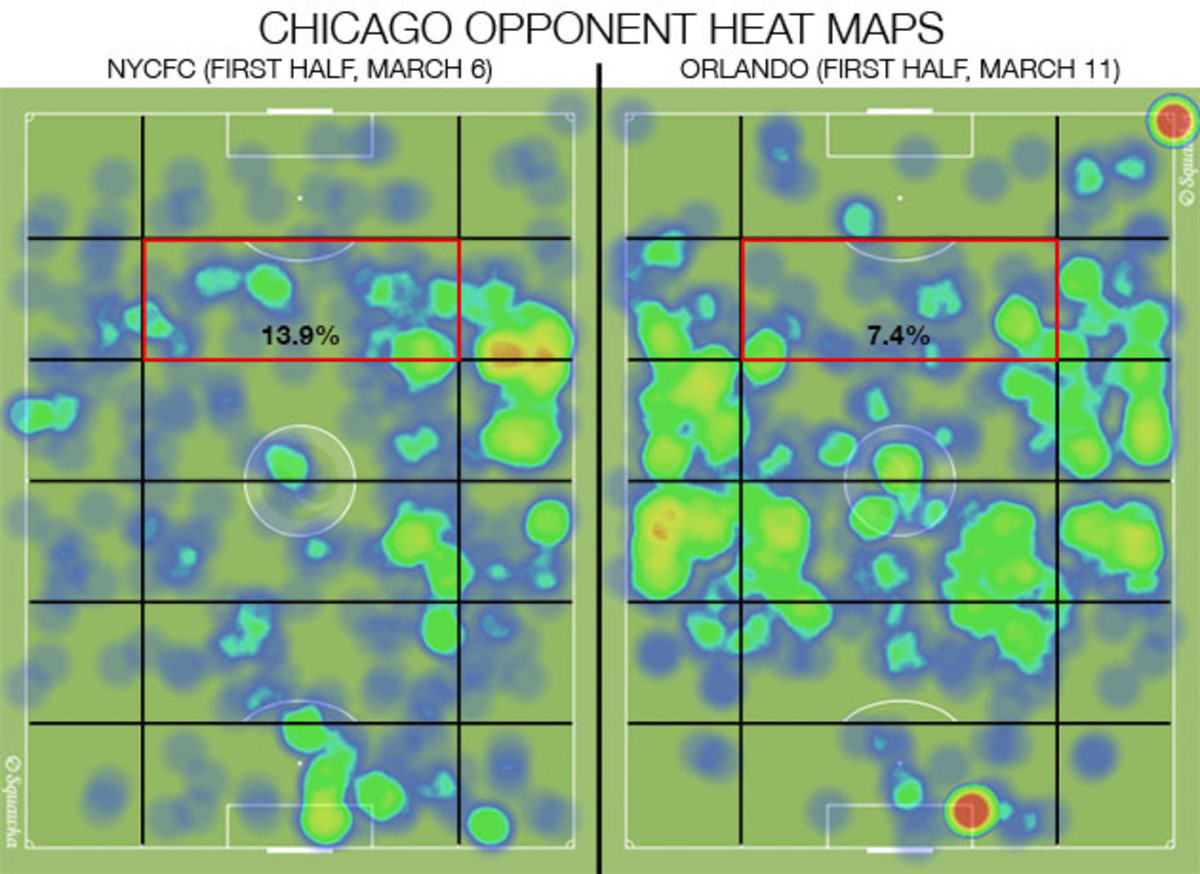
The resulting influence on the opposition across the two weeks showed why NYCFC created five chances in the central zone on top of the penalty area in the first half, while Orlando mustered two. With easier access to that area (“Zone 14” in tactical parlance), 13.9% of NYCFC’s actions occurred there, while just 7.4% of Orlando’s did.
Chicago pushed Orlando wider, forcing lower-percentage passes in most situations. It’s impossible to tell what would have happened over the balance of 90 minutes without the red card, but look for Chicago to switch between its two systems as games dictate, depending on the opponent’s strengths and whether the Fire has more or less of the game or a lead to protect.
The SI Extra Newsletter Get the best of Sports Illustrated delivered right to your inbox
Subscribe
Attacking Player of the Week: Andrew Wenger, Houston Dynamo
It’s been a long road for Wenger, the first pick in the 2012 MLS SuperDraft. Recently traded to the Dynamo after bouncing from Montreal to Philadelphia, he hasn’t made as much of an impact on the pro level as he did in a stellar college career.
Saturday, he put up just the third multi-point game of his MLS tenure, assisting twice and scoring once in a blowout against Dallas. His goal put a cap on an outrageous first half-hour, in which the Dynamo went up 4-0.
MLS teams still unable to solve CONCACAF Champions League
Wenger dipped a pinpoint cross between two defenders and onto David Horst’s head in the sixth minute for Houston’s first goal, followed by a smart cutback cross into Ricardo Clark’s path at the top of the penalty area in the 23rd.
Finally, he made an incisive third-man run from the right wing and got a fortuitous bounce off two defenders to score in the 27th.
He might have needed a touch of luck to get the goal, but it was a just reward for his service on the first two and potentially what Wenger needed to kick-start a breakout season in MLS.
Two-goal scorers Chris Pontius, also making a new start with the Union; Dom Dwyer and David Villa receive honorable mentions this week. Dwyer’s first goal, a long-distance bomb from outside the penalty area on a one-man counterattack, would have been the easy pick for Goal of the Week if not for Quincy Amarikwa's long-range chip that will be one of the best of the entire season. Sebastian Giovinco also scored one and assisted the other for Toronto.
Defensive Player of the Week: Andre Blake, Philadelphia Union
Given the No. 1 jersey at the start of the season, Blake has turned in two more than solid performances for Philadelphia in between the sticks to begin 2016. The Jamaican international finished with six saves on Saturday against the Crew, only conceding a consolation goal with just a couple minutes to go.
Behind the MLS Ambition Rankings: Inside info on each team
He’s shown impressive range in his shot-stopping ability already. Late in the first half, he pushed a close-range shot beyond the far post from low to his left, getting down into an area that taller goalkeepers generally struggle to protect.
He also made saves higher to both sides late in the game, though he couldn’t keep out Kei Kamara’s upper-corner header from a corner kick.
Like Wenger, Blake was also a first overall pick in the draft (2014) and the first goalkeeper to be selected first. After the revolving door of gloved guardians that was the Union goal in the last couple years, the coaching staff seems to finally have settled on the solution that was obvious to many on the outside.
Marcelo Sarvas, now of D.C., and the three players tasked with defending centrally for the Impact, Calum Mallace in midfield and Víctor Cabrera and Laurent Ciman in central defense, receive honorable mentions. Sarvas ran the D.C. attack with his distribution, also putting in five successful tackles, five interceptions and six loose-ball recoveries in a scoreless draw.
Cabrera, Ciman and Mallace collectively ensured Montreal’s shutout of the Red Bulls, protecting their own goal brilliantly while also distributing well. It’s hard to separate the three performances in terms of their level and importance to the team, but the three men combined for 21 recoveries, 12 clearances, 16 interceptions, 12 tackles won and only one lost.

1. Montreal Impact
PREVIOUS: 5
RECORD: 2-0-0
Ignacio Piatti scored again, and the Impact continued their attacking tear without Didier Drogba in the lineup in its 3-0 defeat of the Red Bulls.

2. Sporting Kansas City
PREVIOUS: 7
RECORD: 2-0-0
A double from Dom Dwyer, including a thunderous opening goal, carried Kansas City to its second win in a row with a 2-1 result against Vancouver.

3. Portland Timbers
PREVIOUS: 2
RECORD: 1-1-0
The defending champion took a tumble in San Jose despite getting 16 shots to the Earthquakes’ eight and attempting 28 crosses to eight; the trouble was Portland only got two shots on target and only connected on five crosses.

4. Toronto FC
PREVIOUS: 3
RECORD: 1-0-1
Sebastian Giovinco engineered a comeback for TFC at Yankee Stadium on Sunday, assisting on a goal in first-half stoppage time before scoring one in the 76th minute to claw back a 2-2 away draw.

5. FC Dallas
PREVIOUS: 1
RECORD: 1-1-0
Dallas crashed after a strong start in Week 1, with a shocking 5-0 loss to Houston, prompting early questions about the team’s consistency—something that had been an issue in recent years but looked to be rectified last year.

6. San Jose Earthquakes
PREVIOUS: 10
RECORD: 2-0-0
San Jose jumped to a two-goal lead in the first half against the Timbers–punctuated by Quincy Amarikwa's stunner–only conceding a late consolation marker on the way to tying Sporting Kansas City for a very early lead atop the Western Conference.

7. LA Galaxy
PREVIOUS: 4
RECORD: 1-1-0
The Galaxy struggled to get their attack going after a second-half outburst in the first week, falling to a Rapids goal from Marco Pappa deep into stoppage time.

8. Houston Dynamo
PREVIOUS: 14
RECORD: 1-0-1
The Dynamo are MLS’s highest-scoring team after two games following an explosive 5-0 win over rival FC Dallas on Saturday in which Houston led by four inside the first half hour.

9. New York Red Bulls
PREVIOUS: 6
RECORD: 0-2-0
Two weeks, five goals conceded, zero scored and two disappointing losses—the Red Bulls are off to a shaky start after their 2015 Supporters’ Shield-winning season.

10. New York City FC
PREVIOUS: 9
RECORD: 1-0-1
David Villa scored twice in the first half hour, but NYCFC couldn’t make a two-goal lead stick for a victory; Patrick Vieira’s team also trotted out a 3-4-1-2 lineup not frequently seen in MLS.

11. Columbus Crew SC
PREVIOUS: 8
RECORD: 0-2-0
For the second week in a row, Columbus kept 60% possession, adding 19 total shots against Philadelphia but managing to lose by the same 2-1 scoreline as it did the first game.

12. Vancouver Whitecaps
PREVIOUS: 11
RECORD: 0-2-0
Jordan Smith’s red card in first-half stoppage time capped a frustrating half that sank the Whitecaps in Kansas City; Vancouver looked much better in the second half, though, scoring its goal in the 2-1 loss.

13. Seattle Sounders
PREVIOUS: 12
RECORD: 0-2-0
After a loss in the waning minutes to RSL, the Sounders are still without a win in four matches in 2016 after a draw and loss in the CONCACAF Champions League and a Week 1 loss to Sporting KC.

14. Real Salt Lake
PREVIOUS: 15
RECORD: 1-0-1
After being on the wrong end of a stunning two-goal comeback to drop two points on the road last week, RSL scored the winning goal against Seattle in the 86th minute to win its home opener on Saturday.

15. New England Revolution
PREVIOUS: 13
RECORD: 0-0-2
The Revs’ shot chart from Saturday is an absolute mess, with lines crisscrossing the goal from every direction, but New England only hit the target three times (once from inside the penalty area) in a goalless draw with D.C.

16. Philadelphia Union
PREVIOUS: 20
RECORD: 1-1-0
New acquisition Chris Pontius came up with two goals, and Andre Blake was again huge on the other end as the Union won in Columbus for the first time in franchise history, 2-1.

17. Orlando City SC
PREVIOUS: 16
RECORD: 0-0-2
Cyle Larin scored in the first five minutes and should have also won a penalty in stoppage time, but referee Ted Unkel didn’t blow his whistle, and Orlando finished with its second draw in two weeks.

18. Colorado Rapids
PREVIOUS: 19
RECORD: 1-1-0
Sometimes, teams in scoring slumps need something emphatic to break their slump, and that’s what Colorado got from second-half substitute Pappa’s late volley to beat LA 1-0 on Saturday.

19. Chicago Fire
PREVIOUS: 17
RECORD: 0-1-1
A fairly early red card for Michael Harrington doomed the Fire to playing with 10 for nearly an hour away from home against Orlando, but Chicago still managed to grind out its first point under Veljko Paunović.

20. D.C. United
PREVIOUS: 18
RECORD: 0-1-1
United’s attack will be a big question mark this year, as the team didn’t get any clear looks at goal despite eight shots and three on target at New England, leading to a goalless draw.
